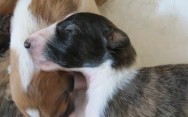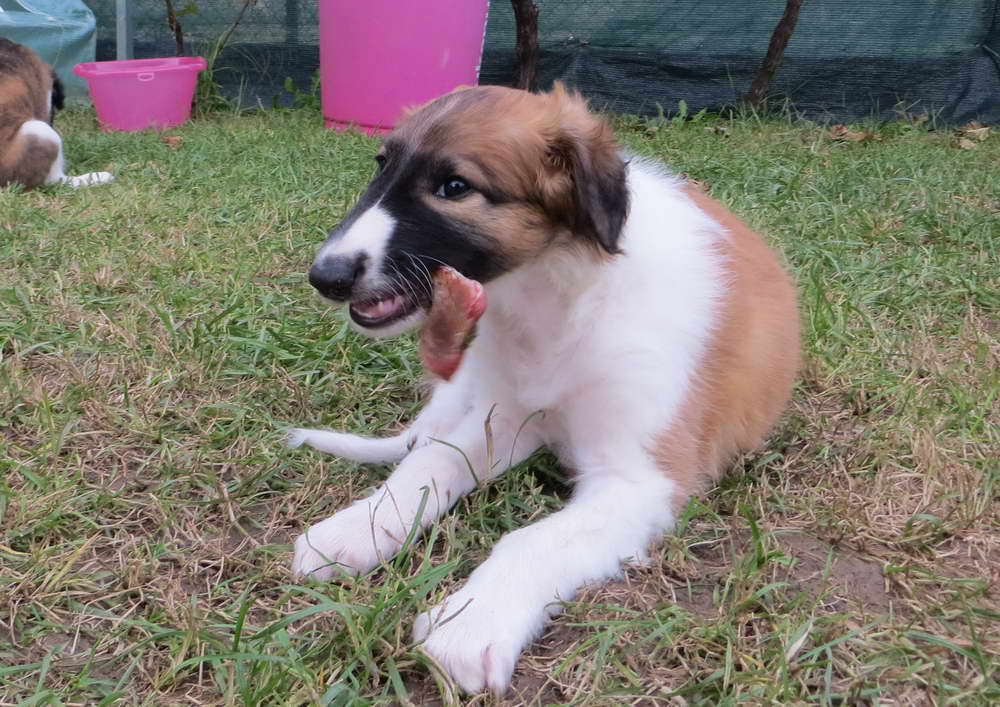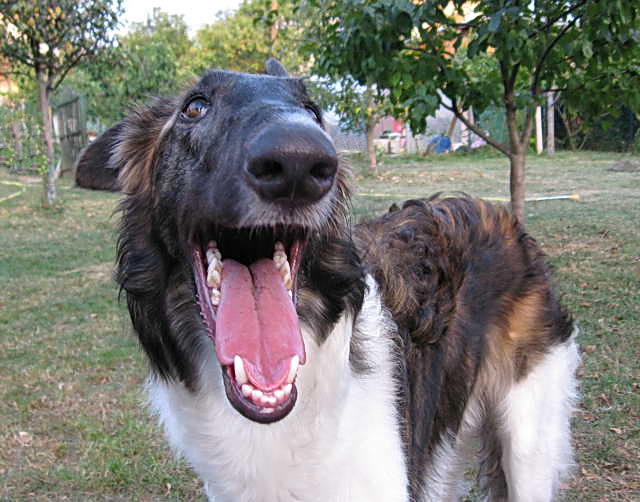BORZOI …dostojanstven, samostalan, elegantan i plemenit pas.
.
Kad pomislim na borzoja u mašti mi se stvori slika Carske Rusije i širokih prostranstava te velike zemlje. Plemići su na konjima. Pored svakoga je po nekoliko visokih, snažnih pasa, uzdrhtalih od žudnje. Nosnice im se šire, vrat je izdužen, svi mišići napeti, povremeno podignu uške osluškujući. Njihove velike oči, boje tamne svile, pretražuju horizont. Oni znaju. Sprema se lov. I tada polete, polete parajući zrak svojim vitkim tijelima. U tišini. Čuje se samo topot nogu, disanje konja i škripa sedla. Nevjerojatnom brzinom i spretnošću love svoj plijen. Oni su savršenstvo sklada i učinkovitosti.
Njegova uzgajivačnica Pershino postala je najveća i u zapadnom svijetu najpoznatija. Međutim, njena povijest započinje puno ranije, kada je Ruska carica Katarina darovala poznatom bankaru Lasarieffu veliki posjed u provinciji Tulsk (Tula). Njegov zet, veliki ljubitelj lova, na posjedu je prvi počeo uzgajati hrtove. Tokom sljedećih godina, na imanju su se smjenjivala doba blagostanja i doba nemira i neimaštine. Uzgajivačnica Pershino doživljava svoj procvat tek pod upravom kneza Nikolaja. Kao predsjednik Društva za poticanje sporta 1889. godine napisao je Borzoi standard. 
I ostali ruski plemići osnivali su uzgaivačnice s brojnim hrtovima. Ovisno o osobnim lovačkim sklonostima plemića-vlasnika i uvezenim ”zapadnjačkim ” psima s kojima su prije parili svoje pse, nastali su razni tipovi ruskih hrtova nazvanih po imenima uzgajivačnica. Raznolikosti tipova pridonijela je i veličina ruske zemlje. Udaljenosti između pojedinih imanja bile su velike i svaka uzgajivačnica je bila kao otok u oceanu. Zahvaljujući nekolicini uzgajivača sačuvan je čisti tip borzoja i do kraja devetnaestog stoljeća, njihova svojstva su postala određenija. Dvije veće uzgajivačnice, Gustopsovoy i Christopsovoy razmjenjivale su pse i zajedno su ustalile jedinstven tip, danas poznat kao ”ruski hrt”.
Prema zapisima, na kraju devetnaestog stoljeća isticalo se 7 uzgajivačnica. Najpoznatija među njima bila je, već spomenuta uzgajivačnica Pershino. Ostale su bile: Oseroff (Ozerov), Boldareff (Boldirev), Tschelischtscheff (Chilischev), Sumarokoff (Sumarkov), Gejeroff (Geyer) i Bibikof (Bibnikov). Pasmina se oporavila i taj dio povijesti je možda bilo najsretnije doba za borzoje.
Živjeli su život za koji su i stvoreni – život lovca. Kao takvi, predstavljali su veliku dragocjenost i smio ih je posjedovati samo pripadnik plemstva. Nisu se prodavali niti kupovali. To je bilo nezamislivo. Poklanjali su ih kao nagradu zaslužnim pripadnicima dvora, ili kao dragocjen poklon okrunjenim glavama po Evropi. Živjeli su u boljim uvjetima nego većina stanovništva tadašnje Rusije. Bili su aristokratski psi. Navodno je do 1918 . godine bio na snazi zakon koji je propisivao smrtnu kaznu za neovlašteno posjedovanje borzoja. Plemstvu nije bilo u interesu da itko krivolovi po njihovim lovištima, pogotovo ne s jednim tako savršenim bićem kao što je to borzoi.  1904. godine izbija Rusko – japanski rat. Porazi i velike žrtve u tom ratu ubrzavaju revolucionarnu eksploziju kroz decenije akumuliranog nezadovoljstva. 1905. godine započinje prva buržoasko – demokratska revolucija, a 9 godina kasnije, 1. Svjetski rat (1914. – 1918.). Zaostala privreda carske Rusije nije mogla osiguravati goleme potrebe armije. Iscrpljena zemlja približavala se ekonomskoj katastrofi. Krupna buržoazije se bogatila ratnim profiterstvom, položaj radnih masa naglo se pogoršavao. Uz to i nezadovoljstvo carskim režimom stvaralo je u zemlji revolucionarnu situaciju. 1917. i 1918. demokratska revolucija prelazi u proletersku kako bi se u Velikom Oktobru prvi put na šestini zemaljske kugle ostvarila diktatura proletarijata.
1904. godine izbija Rusko – japanski rat. Porazi i velike žrtve u tom ratu ubrzavaju revolucionarnu eksploziju kroz decenije akumuliranog nezadovoljstva. 1905. godine započinje prva buržoasko – demokratska revolucija, a 9 godina kasnije, 1. Svjetski rat (1914. – 1918.). Zaostala privreda carske Rusije nije mogla osiguravati goleme potrebe armije. Iscrpljena zemlja približavala se ekonomskoj katastrofi. Krupna buržoazije se bogatila ratnim profiterstvom, položaj radnih masa naglo se pogoršavao. Uz to i nezadovoljstvo carskim režimom stvaralo je u zemlji revolucionarnu situaciju. 1917. i 1918. demokratska revolucija prelazi u proletersku kako bi se u Velikom Oktobru prvi put na šestini zemaljske kugle ostvarila diktatura proletarijata.  Rusiji nestaje plemstva. Bila je to velika tragedija i ljudi i životinja. Sve što je asociralo na aristokraciju, bilo je uništavano. Nestale su gotovo sve uzgajivačnice. Mali broj plemstva uspio je sa svojom psima prebjeći u Evropu, pretežno u Holandiju. Neki su se borzoi razbježali po šumama i podivljali, dok su većinu gnjevni revolucionarni vojnici pobili. Pasmina je ponovo bila na rubu izumiranja. U cijeloj Rusiji, 1920. ostalo je svega nekoliko desetaka čistokrvnih borzoja i to u Moskvi i Petrogradu. Na svu sreću, komunistička vlast je dozvolila da Chelischev, Sumarokov i V. Mamontov spase svoje pse. Oni su nastavili rad u državnim uzgajivačnicama, počevši gotovo od ničega i uspjeli sačuvati pasminu. Danas ima u Rusiji samo oko 2000 borzoja s autentičnim pedigreom. Borzoi, veličanstveni pas stvoren za lov, građe koja do savršenstva udovoljava namjeni, danas gotovo nigdje više ne lovi. Pas koji nije bio uzgajan kao kućni ljubimac, nenaviknut na maženje, potpuni individualac, postaje izložbeni pas. Izgled dolazi na prvo mjesto. I ponovo je pasmina ugrožena.
Rusiji nestaje plemstva. Bila je to velika tragedija i ljudi i životinja. Sve što je asociralo na aristokraciju, bilo je uništavano. Nestale su gotovo sve uzgajivačnice. Mali broj plemstva uspio je sa svojom psima prebjeći u Evropu, pretežno u Holandiju. Neki su se borzoi razbježali po šumama i podivljali, dok su većinu gnjevni revolucionarni vojnici pobili. Pasmina je ponovo bila na rubu izumiranja. U cijeloj Rusiji, 1920. ostalo je svega nekoliko desetaka čistokrvnih borzoja i to u Moskvi i Petrogradu. Na svu sreću, komunistička vlast je dozvolila da Chelischev, Sumarokov i V. Mamontov spase svoje pse. Oni su nastavili rad u državnim uzgajivačnicama, počevši gotovo od ničega i uspjeli sačuvati pasminu. Danas ima u Rusiji samo oko 2000 borzoja s autentičnim pedigreom. Borzoi, veličanstveni pas stvoren za lov, građe koja do savršenstva udovoljava namjeni, danas gotovo nigdje više ne lovi. Pas koji nije bio uzgajan kao kućni ljubimac, nenaviknut na maženje, potpuni individualac, postaje izložbeni pas. Izgled dolazi na prvo mjesto. I ponovo je pasmina ugrožena.












